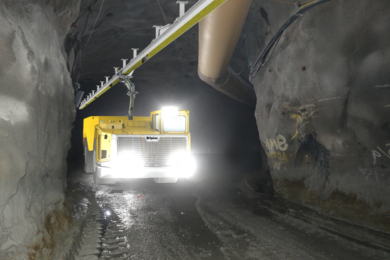New Gold’s Rainy River gold operation northwest of Fort Frances, Ontario and Glencore’s Antapaccay copper mine in Peru have both benefitted from deployment of SmartRView technology from Canadian company Cascadia Scientific on mine haul trucks which can then be used to identify road segments with higher fuel intensity, such as uneven grading and inconsistent slopes, and these areas marked for improvements. This has resulted in significant fuel and emissions savings for both mines.
Cascadia Scientific uses precision fuel flow meters, corrected for temperature and viscosity to capture highly accurate fuel consumption data over short intervals. This data is coupled with data captures from the engine ECM, payload measurements system, on-board altimetry, and motion sensors to produce geo-spatially referenced breadcrumbs on 10-15 second intervals. These ‘breadcrumbs’ are combined and analysed to create a visual representation of fuel intensity across the haul road network. Areas of the heat map that appear as a deep red are those associated with the highest fuel consumption per unit distance travelled. Identification of these areas triggers closer examination of regions with highest consumption and corresponding excess emissions.
Reduction of greenhouse gas (GHG) emissions and managing its environmental impacts are key elements of New Gold’s Sustainability Strategy. New Gold has committed to a reduction of GHG emissions by 30% by 2030. In 2022, the Rainy River Mine began installation of new equipment on its haul trucks provided by Cascadia Scientific to manage, report and assist in identifying opportunities to reduce haul truck fuel consumption and resulting emissions.
It says this technology provides the operations with information such as identifying ‘hot spots’ along the haul road requiring attention, as well as notification when haul trucks accelerate or idle unnecessarily. The data guides the maintenance, operations, dispatch, and training departments to pinpoint areas for real-time improvements. All haul trucks are now fully equipped and Rainy River Mine says it continues to monitor and quantify the GHG emissions data to support achieving its emission reduction goals.
“People are key to any successful energy or GHG management initiative – they are the drivers here – and are definitely committed to digging into a more efficient tomorrow,” said Rainy River Energy Specialist Cheryl Maki.
This fuel initiative, along with biodiesel supply utilised during warmer months resulted in an annual tracked avoidance of two million litres of fuel and CO2 equivalent reductions of over 7,000 t in 2023, which exceeded Rainy River’s annual target of 3,800 t/CO2 equivalent for its diesel fuel-attributed emissions.
New Gold added: “Moving forward in 2024, our energy and GHG-reduction projects will continue to focus on optimising processes, supporting electrical grid reliability for the region, using biodiesel as a fuel source, reducing energy/fuels across the HVAC systems, updating to LED lighting with controls, and using waste heat generated by the site as a free and renewable energy source.”
Glencore, in collaboration with Cascadia Scientific, conducted a study to improve the haul roads at the Antapaccay mining operation. The study utilised Cascadia’s SmartRView platform for data collection, complemented by precise instrumentation installed on both Komatsu and Caterpillar haul trucks.
Antapaccay worked closely with Cascadia’s data scientists, employing various statistical methods to analyse the data and identify potential enhancements to the haul road design. The study utilised Cascadia Scientific’s heat mapping tool to identify road segments with high fuel intensity. As a result, four main road segments were identified for improvement. With the collaboration of Antapaccay’s operations staff, these road segments were regraded, including one section where the grade was reduced by 0.34%. These road improvements led to cost and environmental benefits amounting to fuel savings of US$1.4 million and a reduction of 9,000 t of CO2 emissions.










